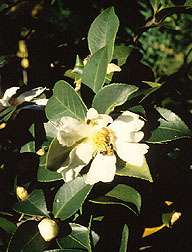Camellia oleifera
Camellia oleifera, which originated in China, is notable as an important source of edible oil (known as tea oil or camellia oil) obtained from its seeds.[2] It is commonly known as the oil-seed camellia or tea oil camellia, though to a lesser extent other species of camellia are used in oil production too.
| Oil-seed camellia | |
|---|---|
 | |
| Scientific classification | |
| Kingdom: | Plantae |
| Clade: | Tracheophytes |
| Clade: | Angiosperms |
| Clade: | Eudicots |
| Clade: | Asterids |
| Order: | Ericales |
| Family: | Theaceae |
| Genus: | Camellia |
| Species: | C. oleifera |
| Binomial name | |
| Camellia oleifera | |
It is widely distributed in China and is cultivated extensively there. It is found in forests, thickets, banks of streams and foothills at elevations of 500 to 1,300 metres.[3]
This species looks much similar to Camellia sasanqua except the dark green, evergreen leaves are a bit larger, three to five inches long and two to three inches wide. Single, white, fragrant flowers are produced in mid to late fall, and this large shrub or small tree will reach a height of 20 feet with thin, upright, multiple trunks and branches. The crown forms a rounded or oval vase with lower branches removed.[4]
Uses
The seeds of Camellia oleifera can be pressed to yield tea seed oil, a sweetish seasoning and cooking oil. In tea seed oil, oleic acid, a monounsaturated fatty acid comprises ~80% of the total fatty acid content - the oil is similar in composition to olive oil.
Tea oil is also known as "Tea Seed Oil" when sold as cooking oil in supermarkets throughout Australia, New Zealand and the United States.[5]
It can also be used in textile manufacture, soap making and as an illuminant.[3] Camellia oil is also traditionally used to protect Japanese woodworking tools and cutlery from corrosion and is currently sold for that purpose.[6][7]
See also
- Tea tree oil is derived from Melaleuca alternifolia - it is an essential oil used for medical and cosmetic purposes and is toxic when ingested.
- Tea tree is a name sometimes applied to a number of different species of plants endemic to Australia. These plants are unrelated to the tea plant.
References
- Wheeler, L. 2015. Camellia oleifera. The IUCN Red List of Threatened Species 2015: e.T62056210A62056214. https://doi.org/10.2305/IUCN.UK.2015-4.RLTS.T62056210A62056214.en. Downloaded on 22 October 2018.
- The Huntington Botanical Gardens: The Camellia Garden Archived 2014-02-24 at the Wayback Machine
- Plants for a Future
- Camellia oleifera
- Antioxidant Activity and Bioactive Compounds of Tea Seed (Camellia oleifera Abel.)
- Odate, T: "Japanese Woodworking Tools: Their Tradition, Spirit, and Use" page 174. Linden Publishing, Reprint edition 1998.
- Nakahara, Y; Sato, H.; Nii, P.: "Complete Japanese Joinery: A Handbook of Japanese Tool Use and Woodworking for Joiners and Carpenters" pages 5, 15, 28. Hartley & Marks Publishers, 1998
External links


